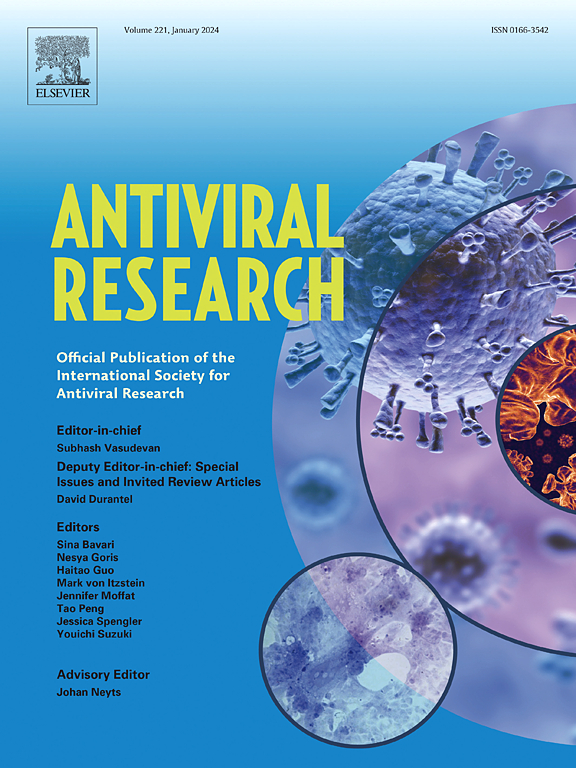Immunostimulatory effects of multiple short-hairpin RNAs enhance foot-and-mouth disease vaccine-induced humoral immunity
IF 4
2区 医学
Q1 PHARMACOLOGY & PHARMACY
引用次数: 0
Abstract
Small interfering RNAs are typically used to block gene expression via the sequence-specific degradation of mRNA. We previously developed a recombinant adenovirus expressing three short hairpin RNAs, targeting foot-and-mouth disease virus (FMDV) driven by the U6 promoter (Ad-3siRNA). These exhibited rapid antiviral effects against FMDV. Herein, we investigated the immunostimulatory effects of Ad-3siRNA in combination with an FMD inactivated vaccine. Ad-3siRNA induced various cytokines, including type I interferon, and upregulated interferon-stimulated genes in swine cells. Using the combination of Ad-3siRNA and a foot-and-mouth disease (FMD) inactivated vaccine, we observed enhanced protection efficacy until 1 week post-vaccination and enhanced neutralizing antibody levels from 1 week post-vaccination in mice. Furthermore, humoral immunity was significantly enhanced in pigs injected with a vaccine and a combination of Ad-3siRNA for 7 weeks post-vaccination. Ad-3siRNA induced various cytokines, such as IFN-α, IFN-γ, IL-12, IL-6, IL-15 and IL-18, in mice. In conclusion, we demonstrated that Ad-3siRNA, a novel immunostimulatory RNA delivered by a human adenoviral vector, could enhance protection and humoral immunity in combination with an FMD-inactivated vaccine. Exploring the applications of Ad-3siRNAs against other viral diseases and further detailed mechanistic studies are warranted.
多种短发夹rna的免疫刺激作用增强口蹄疫疫苗诱导的体液免疫。
小干扰rna通常通过mRNA的序列特异性降解来阻断基因表达。我们之前开发了一种表达三个短发夹rna的重组腺病毒,靶向由U6启动子(Ad-3siRNA)驱动的口蹄疫病毒(FMDV)。它们对FMDV表现出快速的抗病毒作用。在此,我们研究了Ad-3siRNA与口蹄疫灭活疫苗联合使用的免疫刺激作用。Ad-3siRNA诱导多种细胞因子,包括I型干扰素,并在猪细胞中上调干扰素刺激基因。使用Ad-3siRNA和口蹄疫灭活疫苗的组合,我们观察到小鼠在接种后1周的保护效果增强,并且在接种后1周的中和抗体水平增强。此外,在接种疫苗后7周,注射疫苗和Ad-3siRNA组合的猪的体液免疫显着增强。Ad-3siRNA诱导小鼠多种细胞因子,如IFN-α、IFN-γ、IL-12、IL-6、IL-15和IL-18。总之,我们证明了由人腺病毒载体递送的新型免疫刺激RNA Ad-3siRNA与口蹄疫灭活疫苗联合使用可以增强保护和体液免疫。探索ad - 3sirna在其他病毒性疾病中的应用和进一步详细的机制研究是必要的。
本文章由计算机程序翻译,如有差异,请以英文原文为准。
求助全文
约1分钟内获得全文
求助全文
来源期刊

Antiviral research
医学-病毒学
CiteScore
17.10
自引率
3.90%
发文量
157
审稿时长
34 days
期刊介绍:
Antiviral Research is a journal that focuses on various aspects of controlling viral infections in both humans and animals. It is a platform for publishing research reports, short communications, review articles, and commentaries. The journal covers a wide range of topics including antiviral drugs, antibodies, and host-response modifiers. These topics encompass their synthesis, in vitro and in vivo testing, as well as mechanisms of action. Additionally, the journal also publishes studies on the development of new or improved vaccines against viral infections in humans. It delves into assessing the safety of drugs and vaccines, tracking the evolution of drug or vaccine-resistant viruses, and developing effective countermeasures. Another area of interest includes the identification and validation of new drug targets. The journal further explores laboratory animal models of viral diseases, investigates the pathogenesis of viral diseases, and examines the mechanisms by which viruses avoid host immune responses.
 求助内容:
求助内容: 应助结果提醒方式:
应助结果提醒方式:


